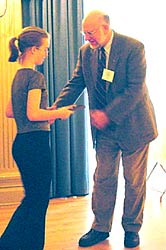Stars and STEM Stories
A Student's Question Leads to National Award, IA, USA
"Can the actions of man change a pixel's MUC code?" In the course of her land cover studies, fifth-grader Megan of Shenandoah Middle School in Iowa asked that question. Her quest for an answer led her to a national science award. The National Aeronautics and Space Administration (NASA) Stennis Space Center awarded Megan first place in the "Watching Earth Change" division of the NASA Student Involvement Program (NSIP), grades 5-8 division, for her project, "Loess Hills, Gentle Giants."

The Iowa Academy of Science and the Iowa Junior Academy of Science added to the honor April 19 when they awarded Megan special recognition for "extending her GLOBE Iowa classroom learning to win" the NASA prize.
"Megan is an example of the success of the GLOBE inquiry process," says Marcy Seavey, Education Director of the Iowa Academy of Science, also a GLOBE Partner. "She looked at the world around her, asked how that world was changing, and then answered her own question using research and GLOBE skills."
Megan's GLOBE class was studying MUC classification, matching pictures from magazines of trees, shrubs, grasses and other land cover vegetation types to the GLOBE MUC classification guide. She knew a rare soil - "loess" - is found only in the Missouri River corridor in the United States, which is near her home in western Iowa, and in China, halfway across the GLOBE.
Megan knew some private landowners were developing the hills in ways she thought might impact the land cover and biology of the area. In the course of her research, she spoke with Brad Cutler, a Geographic Information Systems (GIS) specialist with Golden Hills Resources Conservation and Development, a nonprofit dedicated to research and preservation of natural resources in the area.
"Megan was asking very large questions, a very broad question for someone her age. But she approached it in a very scientific, step-by-step manner," Cutler said. "She asked good questions and we were able to give her some insight. We talked about development and about the National Park Service [study] of the area."
As Megan's paper states, loess (pronounced "luss") was formed 10,000 - 20,000 years ago. The Loess Hills is a landform of windblown glacier-soil deposits along the eastern edge of the Missouri River Valley. It has land cover/biology features found only there and in the Yellow River Valley of China. The landscape of prairies and forested bluffs is home to much rare wildlife found only within its ecosystem. There, steep, sharp ridges were formed by deposits and by erosion of wind-blown silt and soil left by the glaciers. Now, as discussed in Megan's paper, the erosion has escalated from human activities.
"Loess is the source of Iowa's rich agricultural soils in which 2.5 million people are supported by ... activities in the heartland," Megan writes. "Conflicts have started between people who want to expand urbanization and people who want the land for agricultural use."
Although farming has affected the hills, Megan's paper states that urbanization and housing development are escalating the deterioration. Farmers, in fact, want to protect prairies, which include many miles of the Loess Hills, according to Megan.
"Nature changes our landscape over geologic time and events, whereas man changes our landscape over a very short time period," Megan's paper concludes.
Her project will be considered once more among the first-place winners from other NASA centers. Stennis Space Center is NASA's Center of Excellence for Rocket Propulsion Testing, which maintains and runs engine test-firing stands and funds and provides expertise in applications of Earth remote-sensing data.
26 April 2002





